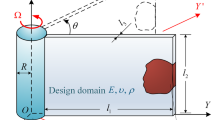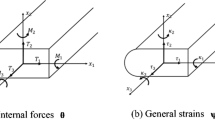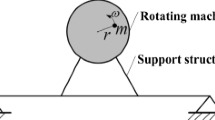Abstract
Optimal configurations of circular bars under free torsional and longitudinal vibration are investigated using the Pontryagin’s maximum principle (PMP). The necessary optimality condition of PMP is analysed by considering the cross-sectional area of bars as control variable and by using Maier objective functional to control the final state of the objective functional. Optimal configurations associated to different orders of eigen frequencies, eigen vectors, and specific boundary conditions are demonstrated. Their relations are also explained qualitatively. Numerical results show the equivalent about optimal configurations and eigen frequencies under specific boundary conditions.






Similar content being viewed by others
Abbreviations
- A :
-
Cross-sectional area of the bar
- c ωi :
-
Coefficient in the objective function
- c W :
-
Coefficient in the objective function
- d e :
-
Diameter of element e
- d max :
-
Maximum diameter
- d min :
-
Minimum diameter
- E :
-
Elastic modulus
- F :
-
Objective function
- G :
-
Shear modulus
- H :
-
Hamiltonian function
- J p :
-
Polar moment of inertia of the cross-sectional area of the circular bar
- k ωW :
-
Non-negative weight, k ωW ∈ [0, 1)
- L :
-
Length of the bar
- L e :
-
Length of element e
- M :
-
Internal moment
- m :
-
A positive integer
- N :
-
Internal force
- N H :
-
Adjoint state variable (N H = −p u )
- n :
-
Number of nodes
- n L :
-
A positive integer
- p N :
-
Adjoint variable of N
- p W :
-
Adjoint variable of W
- p u :
-
Adjoint variable of u
- p ω :
-
Adjoint variable of ω
- W :
-
Total weight of the bar
- W 0 :
-
The total weight of the initial bar (before optimization)
- [k] e :
-
Stiffness matrix of the eth element
- [m] e :
-
Mass matrix of the eth element
- [K]:
-
Global stiffness matrix
- [M]:
-
Global mass matrix
- u :
-
Displacement
- u H :
-
Adjoint state variable (u H = p N )
- ρ :
-
Mass density
- ω i :
-
The ith natural frequency
- ω 0i :
-
The ith natural frequency of the initial bar (before optimization)
References
Hagedorn P, DasGupta A (2007) Vibrations and waves in continuous mechanical systems. Wiley, England
Rao SS (2007) Vibration of continuous systems. Wiley, USA
Ma H, Lu Y, Wu Z et al (2015) A new dynamic model of rotor–blade systems. J Sound Vib. doi:10.1016/j.jsv.2015.07.036i
Sihler C (2006) A novel torsional exciter for modal vibration testing of large rotating machinery. Mech Syst Signal Process 20:1725–1740
Murawski L, Charchalis A (2014) Simplified method of torsional vibration calculation of marine power transmission system. Mar Struct 39:335–349
Astashev VK, Babitsky VI (2007) Ultrasonic processes and machines—dynamics, control and applications. Springer, USA
Al-Budairi H, Lucas M, Harkness P (2013) A design approach for longitudinal–torsional ultrasonic transducers. Sens Actuators A 198:99–106
Yi Y, Seemann W, Gausmann R, Zhong J (2005) Development and analysis of a longitudinal and torsional type ultrasonic motor with two stators. Ultrasonics 43:629–634
Kubojima Y, Sonoda S (2015) Measuring Young’s modulus of a wooden bar using longitudinal vibration without measuring its weight. Eur J Wood Prod. doi:10.1007/s00107-015-0884-2
Pontryagin LS, Boltyanskii VG, Gamkrelidze RV, Mishchenko EF (1962) The mathematical theory of optimal processes. Wiley, England
Szymczak C (1983) Optimal design of thin walled I beams for extreme natural frequency of torsional vibrations. J Sound Vib 86:235–241
Szymczak C (1984) Optimal design of thin walled I beams for a given natural frequency of torsional vibrations. J Sound Vib 97:137–144
Atanackovic TM, Djukic DS (1991) The influence of shear on the stability of a Pflüger column. J Sound Vib 144:531–535
Atanackovic TM, Simic SS (1999) On the optimal shape of a Pflüger column. Eur J Mech A Solids 18:903–913
Glavardanov VB, Atanackovic TM (2001) Optimal shape of a twisted and compressed rod. Eur J Mech A Solids 20:795–809
Atanackovic TM, Braun DJ (2005) The strongest rotating rod. Int J Non-Linear Mech 40:747–754
Atanackovic TM, Novakovic BN (2006) Optimal shape of an elastic column on elastic foundation. Eur J Mech A Solids 25:154–165
Atanackovic TM (2007) Optimal shape of a strongest inverted column. J Comput Appl Math 203:209–218
Atanackovic TM (2007) Optimal shape of a rotating rod with unsymmetrical boundary conditions. J Appl Mech 74:1234
Jelicic ZD, Atanackovic TM (2007) Optimal shape of a vertical rotating column. Int J Non-Linear Mech 42:172–179
Braun DJ (2008) On the optimal shape of compressed rotating rod with shear and extensibility. Int J Non-Linear Mech 43:131–139
Atanackovic TM, Jakovljevic BB, Petkovic MR (2010) On the optimal shape of a column with partial elastic foundation. Eur J Mech A Solids 29:283–289
Glavardanov VB, Spasic DT, Atanackovic TM (2012) Stability and optimal shape of Pflu¨ger micro/nano beam. Int J Solids Struct 49:2559–2567
Atanackovic TM, Novakovic BN, Vrcelj Z (2012) Shape optimization against buckling of micro- and nano-rods. Arch Appl Mech 82:1303–1311
Le MQ, Tran DT, Bui HL (2012) Optimal design of a torsional shaft system using Pontryagin’s maximum principle. Meccanica 47:1197–1207
Bui HL, Tran DT, Le MQ, Tran MT (2015) Multi-objective optimal control for eigen-frequencies of a torsional shaft using Pontryagin’s maximum principle. Meccanica. doi:10.1007/s11012-015-0162-8
Thorby D (2008) Structural dynamics and vibration in practice. Elsevier, USA
Geering HP (2007) Optimal control with engineering applications. Springer, Berlin
Lebedev LP, Cloud MJ (2003) The calculus of variations and functional analysis with optimal control and applications in mechanics. World Scientific, Singapore
Acknowledgments
This research is funded by Vietnam National Foundation for Science and Technology Development (NAFOSTED) under Grant Number 107.02-2012.03.
Author information
Authors and Affiliations
Corresponding author
Appendix: Proof of the necessary optimality condition (11b) cited in the Sect. 2.2
Appendix: Proof of the necessary optimality condition (11b) cited in the Sect. 2.2
The natural frequency ω i is here considered as a state variable. It means that the role of ω i is equivalent to those of u and N in Eq. (2b). The total weight W is also a state variable. So, the state Eq. (2b) of the bar can be rewritten in the form:
The objective function, Eq. (10), can be rewritten in term of the Maier objective functional as follows:
The Hamiltonian function H can be established as follows:
The adjoint equations can be expressed under the following forms:
The adjoint variables \(p_{\varphi } ,p_{M} ,p_{\omega } ,p_{w}\) are determined as below:
where m = 4; y 1 = u, y 2 = N, y 3 = ω i and y 4 = W are state variables and p 1 = p u , p 2 = p N , p 3 = p ω and p 4 = p W are adjoint variables. Thus,
Or,
We obtain:
and other expressions which are depended on the boundary conditions of the bar system as:
-
(a)
$${\text{free}}{\text{-}}{\text{free:}}\;N(0) = N(L) = 0\;(3{\text{b}}) \Rightarrow p_{u} (L) = 0;p_{u} (0) = 0$$(23a)
-
(b)
$${\text{fixed}}{\text{-}}{\text{free:}}\;u(0) = 0,N(L) = 0\; (4{\text{b)}} \Rightarrow p_{u} (L) = 0;p_{N} (0) = 0$$(23b)
-
(c)
$${\text{free}}{\text{-}}{\text{fixed:}}\;N(0) = 0,u(L) = 0\; (5{\rm b})\Rightarrow p_{N} (L) = 0;p_{u} (0) = 0$$(23c)
-
(d)
$${\text{fixed}}{\text{-}}{\text{fixed:}}\;u(0) = 0,u(L) = 0\; (6{\text{b)}} \Rightarrow p_{N} (L) = 0;p_{N} (0) = 0$$(23d)
Assigning:
Combining Eqs. (18a), (18b) and (24) yields:
Equations (23a, 23b, 23c, 23d) can be rewritten as follows:
-
(a)
$$p_{u} (L) = 0;p_{u} (0) = 0\;(23{\rm a}) \Rightarrow N_{H} (0) = 0;N_{H} (L) = 0$$(26a)
-
(b)
$$p_{u} (L) = 0;p_{N} (0) = 0\; (23{\text{b)}} \Rightarrow u_{H} (0) = 0;N_{H} (L) = 0$$(26b)
-
(c)
$$p_{N} (L) = 0;p_{u} (0) = 0\;(23{\text{c}}) \Rightarrow N_{H} (0) = 0;u_{H} (L) = 0$$(26c)
-
(d)
$$p_{N} (L) = 0;p_{N} (0) = 0\;(23{\text{d}}) \Rightarrow u_{H} (0) = 0;u_{H} (L) = 0$$(26d)
It should be emphasized that Eqs. (25) exhibit a similar functional form as Eqs. (2b). Equations (3b, 4b, 5b, 6b) and (26a, 26b, 26c, 26d) take also the same functional forms, describing the boundary conditions of the adjoint system.
Therefore, it can be concluded that an analogy between the adjoint variables and the original variables is obtained. It allows yielding the following equations:
Explicit expression of k can be determined by integrating the Eq. (18c) with appropriate conditions in Eq. (22):
Hence,
Thus, the analogy coefficient k is positive/negative for the case of maximizing/minimizing ω i . It was demonstrated by considering the natural frequency ω i as a state variable. The Hamiltonian function, Eq. (11b), will be maximized if:
where, \(k^{*} = k.\) \(\frac{{c_{W} k_{\omega W} }}{{W_{0} }}\) is a constant, if we have no objective of weight, \(k^{*} = 0.\)
Rights and permissions
About this article
Cite this article
Bui, HL., Tran, MT., Le, MQ. et al. Optimal configurations of circular bars under free torsional and longitudinal vibration based on Pontryagin’s maximum principle. Meccanica 51, 1491–1502 (2016). https://doi.org/10.1007/s11012-015-0324-8
Received:
Accepted:
Published:
Issue Date:
DOI: https://doi.org/10.1007/s11012-015-0324-8




